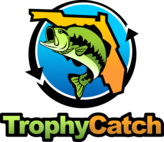
TrophyCatch Season 9 is at its peak right now as we are in the middle of the bass spawn when large females can be found in shallow water (see the article about spawning below). So far this season, which began October 1, 2020, there have been 208 Lunker Club (8-9.9 lbs.), 66 Trophy Club (10-12.9 lbs.), and 6 Hall of Fame (13+ lbs.) bass submitted and approved by TrophyCatch. The current season will run through September 30. Since the program began in 2012, there have been a total of 8,738 Lunker, 2,152 Trophy, and 95 Hall of Fame bass submitted for an incredible total of 10,985 bass caught and released in Florida, the Bass Fishing Capital of the World.
|
The current season leader is Michael Clifton who caught an incredible 14 lbs. 3 oz. bass on an unnamed Putnam County water on February 21. Length was 27 inches with a 22.5-inch girth. Even more amazing, this fish was caught from a kayak.

The inaugural Lake Apopka Fish Tag Challenge is here! If you catch a tagged fish in Lake Apopka between January 15 and May 31, 2021, cut the tag as close to the fish as possible and call 352.406.7879. Friends of Lake Apopka (FOLA) will raffle prizes to lucky anglers with the top prize of $1,000. Additionally, FOLA has partnered with TrophyCatch to tag a 12-pound bass named “Jim Thomas” and if caught during the contest it would be worth $2,500. An additional $2,500 will be awarded if the catch is submitted and approved to www.TrophyCatch.com. TrophyCatch will also award a $500 Bass Pro Shops gift card to the heaviest bass approved to TrophyCatch from Lake Apopka during the contest. Good luck and tight lines!
For more information visit www.FOLA.org.
|
"Jim Thomas" is a 12-pound bass bearing a $2,500 tag! If successfully submitted and approved to TrophyCatch, the angler will win an additional $2,500.

Size: To 20 inches.
Identification and similar species: This unusual fish, normally found in saltwater but able to survive quite well in fresh, is quite distinct compared to other freshwater species. The mottled brown color, large mouth, rounded tail, and lined cheeks identify the bigmouth sleeper. Another primary identification mark, the divided dorsal fin, has led to guesses of walleye by puzzled anglers familiar with this northern species. The only similar species found in Florida is the fat sleeper, another salt-water intruder like its larger relative. Shorter, stockier, and darker, the fat sleeper rarely exceeds ten inches.
Angling qualities: This uncommon fish usually arrives as a surprise to anglers expecting a better-known species at the end of the line. An ambush predator, the bigmouth sleeper usually rests in vegetation waiting for fish to swim within feeding range. As such, it is most often caught when anglers use minnow-imitating lures or live shiners. Not a tremendous fighter, the challenge with this species is not so much to land it, but to identify it!
Where to find them: The bigmouth sleeper occurs in both Atlantic and Gulf coastal areas of much of Florida, and well inland in the state's fresh waters. Despite a fairly broad Florida range, they are usually uncommon to rare wherever found in fresh water.
|
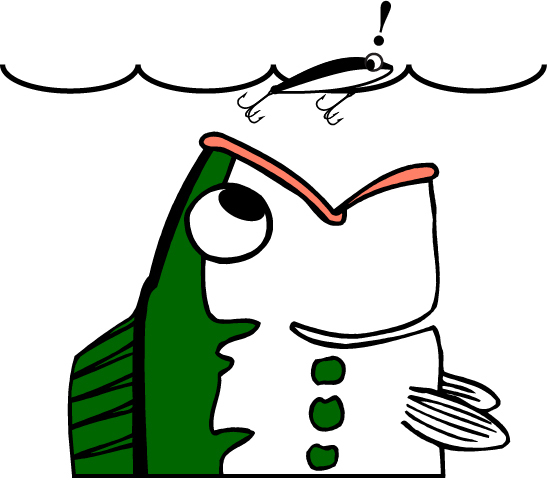 |
One of the great things about the bass spawn and the approaching Spring is that this is an ideal time of year for topwater fishing. Fish caught right at the surface often put on more aerial acrobatics than ones dredged up off the bottom. You can also watch your lure, giving you a more precise awareness of when it’s moving past promising structure than you have when using a plastic worm or crankbait. But the biggest and best reason is being able to actually see the fish strike, rather than just feeling a couple of taps on your line. Topwater fishing can be the most exciting kind of all!
Basic techniques — Your standard bass fishing rig will probably do fine. Use a stiffer rod for solid hook-sets, and a longer rod makes it easier to work a “walk-the-dog” type lure, but you don’t really need a specialized outfit for topwater fishing.
Paying attention is critical. I still painfully recall the morning I was slowly working my largest popper in a quiet cove. I’d just about decided the lure was really too big. I glanced away for a second, and when I looked back my lure was gone. It had been replaced by the boil you might get if you’d just dropped a cinder block in the water. Before I could close my slackened jaw, my lure popped back up — sans bass, of course. Pay attention!
One small detail of topwater fishing demands special mention: Don’t set the hook too soon. New topwater anglers tend to react when they see the strike begin, but pausing slightly before setting the hook will result in more hookups when fishing on top. Experience will tell you how long to pause with specific lure types.
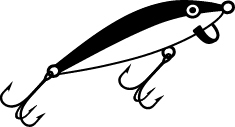
Floater-diver minnow — This is a great technique for largemouth bass, and it also works on larger sunfish. While everyone is familiar with cranking a floater-diver minnow for bass or other species, these lures are also very productive on the surface. Twitch it or crank it for a foot or two underwater, then let it pop up to the surface and wait for the ripples to die before repeating. This method can be extremely productive and is perfect near shallow cover or structure. You can also twitch it continually along the surface without pauses, but I’ve had better luck with the slower technique.
|
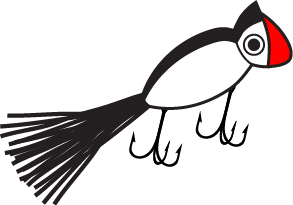
Popper — This is the slowest method of topwater fishing, covering the least amount of real estate for the time invested. However, popper fishing for bass can be pretty effective at times. For the panfish angler, various brands of flyrod poppers are available and work well. The best action of this type occurs if you can locate a large cluster of bream beds.
|
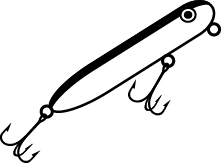
"Walk-the-dog" lure — This subtle lure is at the other extreme from the ruckus-raising buzzbait. When fishing heavily pressured waters and wary bass, tie on a "walking" lure. It takes time and concentration to learn the technique of rhythmically twitching the lure back and forth (“walking the dog”), but it’s worth it. This type of lure can produce fish when nothing else works, both in fresh and salt water.
|
“Walking the dog” takes time and practice to learn but can yield big results.
To properly "walk the dog," twitch your rod tip methodically back and forth. Your goal is to get the lure swinging rhythmically left-right-left as you retrieve it. A longer rod is helpful, since it provides a longer “twitch” than a shorter rod. This will also help reduce wrist fatigue. Although some brands are available in ultralight sizes, larger walking lures which are heavier and have more inertia to make them swing are easier to work.
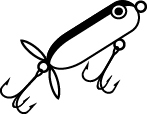
Propeller bait — Also referred to as “prop baits,” there are a variety of brands and styles available. The smaller versions do well on bass and sunfish (ultra-lights are available), while larger prop baits will be better for enticing a big bass up off the bottom. These can be reeled with a steady retrieve that keeps the propellers spinning, worked the same way with twitches thrown in, or fished with a stop-and-go retrieve with rests in between.
|
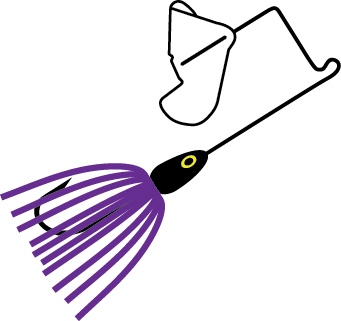
Buzzbait — Save this lure for last in your topwater bass fishing arsenal, because it creates such a ruckus that it may actually scare fish. This lure seems to work best in areas that don’t receive much fishing pressure. However, there is lots of fun to be had fishing with buzzbaits, and these lures also seem to really bring out the aerial antics in bass. Bass may actually leap out of the water and land on top of the buzzbait when taking it. This lure also covers more real estate in a hurry than any other topwater, because of the speed with which it is retrieved and the distance at which it can attract a bass’ attention. Stick with a quick, steady retrieve that keeps the bait up and running briskly. A wide range of colors and designs with single blades, double blades and even counter-rotating blades are available from numerous manufacturers.
|
If you've never done much topwater fishing, now is a great time of year to give it a try. Topwater fishing requires patience and is not the best technique for every situation, but when a giant bass crashes your topwater lure in a spray of froth you take home more than fish photos!
 |
Right now is the peak spawning period for Florida largemouth bass. Spawning plays a very significant role in the lives of nearly all fish. This activity is usually initiated by a rise in water temperatures, and different species will start spawning at different temperatures. The spawning period is usually the most demanding time in a fish’s year: body resources are diverted to production of eggs or milt; territorial disputes and protecting a bed demand energy while at the same time a fish is not free to feed; and protective behaviors may result in injury (even fanning out a bed can abrade skin). All of these factors place a high level of stress on a fish’s body, and any injuries can invite infection during a time when a fish’s immune system has already been weakened by stress. These are some of the reasons that many fish are observed with sores or lesions during this part of the year. The information below is specifically for Florida, as annual water temperatures (and therefore initiation and duration of spawning) can vary markedly from state to state.

Largemouth Bass have been known to spawn between December-June in Florida, but by far most spawning occurs February-April. The triggering water temperature for bass is between 62-75 degrees F. The smaller male will build a shallow nest between 20-30 inches in diameter (roughly twice the size of the individual male building the nest). The female will lay her eggs in the bed, and the male will fertilize the eggs as they are released. Large females may lay as many as 100,000 eggs. Following spawning the male will continue to guard the eggs, which usually hatch within 3-4 days. This parental protection will continue another 2-1/2 to 3 weeks while the bass fry congregate in schools, ending once the fry reach approximately 1/4-3/8 inch in size and begin to disperse.
|
Most trophy largemouth bass in Florida are caught during the peak spawning months of February-March. This is an excellent example of the citizen-science data that the TrophyCatch program is generating.

Black Crappie will nest in colonies from February-April. These fish may become easier to locate and catch as they move inshore to spawn. Nests are fanned by males over gravel or muddy bottoms in depths of 3-8 feet, with bigger fish usually found deeper. Nests are usually located near vegetation or other underwater structure, and males will remain on the nest to guard the eggs after spawning.
|

Bluegill will breed between April-October, but May-June are the peak months. A temperature between 78-80 degrees F will usually trigger spawning in this species. This fish will nest in dense colonies, with one bed often touching the next. The male will fan out a saucer-shaped bed, and the female will deposit between 4,000-60,000 eggs. The male will guard the eggs (they usually hatch within a day and a half) and will continue to guard the young fry for several days.
In south Florida, Redear Sunfish (shellcracker) may spawn as early as the last week of February but more likely around the fourth week of March. In central Florida, they could first go onto spawning beds during late March. In the panhandle, they will likely begin to concentrate in the third or fourth weeks of May. Redear Sunfish may bed well into August.
Bluegill and Redear Sunfish will often nest alongside each other. Nests tend to be located near some kind of aquatic vegetation. Some anglers claim to be able to detect the fishy odor of such colonies, utilizing the technique of “bream sniffing” to locate these prime fishing sites.
|

Channel Catfish will normally begin reproducing when the water temperature reaches 70-85 degrees F. These fish prefer to spawn in larger rivers and lakes with natural underwater cavities to spawn in. Smaller waters may need to be stocked to maintain a catfish population.
|

Butterfly Peacock Bass will spawn from April-September, although activity usually peaks in May-June. A smaller, secondary spawning peak may occur toward the end of their season. A spawning male can often be recognized by the distinct hump that develops on its forehead. The female will lay her 4,000-10,000 eggs on a hard, level surface near shore. Both sexes will protect the eggs and will also guard the hatched fry for up to several months.
|
Size: Highly variable but usually 15 acres or less.
Location: There are thousands of HOA and community lakes and ponds throughout Florida.
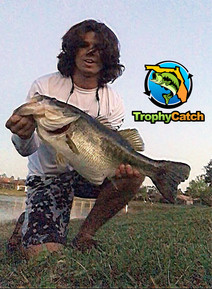
Description: Before you plan a weekend fishing trip where you'll spend more time traveling than fishing, consider wetting a line in your HOA or community lake — you may be pleasantly surprised! Such waters can also be a great choice when you only have an hour before dinner to wet a line and don't have time to fish anywhere farther than your home turf. To put science to this suggestion, the largest bass submitted to the TrophyCatch program to date, a 16 lbs. 12 oz. behemoth caught by angler Dominic Montalto (right), came from a neighborhood pond. Community lakes vary dramatically in quality, with many communities investing in lake plantings and vegetated shorelines that benefit fish and wildlife. Others may opt for elimination of most vegetation, and while FWC recommends 25-30% native plant coverage even these waters can sometimes harbor big bass.
Good lures for these smaller waters include all your normal bass fare: plastic worms, minnow imitations, spinnerbaits, and crankbaits (if deep enough). Many of these lakes are on the shallow side, also making them ideal candidates for topwater fishing (see article above). For bait, shiners remain the perennial favorite but occasionally shad are present in such waters and will also do well attracting a bass' attention.
Fishing pressure is usually very low on community lakes; often, only the local neighborhood kids provide any fishing competition. Such (usually) manmade waters don't have the structural diversity of natural waters, but good locations to target include culverts, piers, bridges, and any existing vegetation stands. If there does happen to be any fallen timber, points, or submerged channels those of course are also excellent locations to target.
So, make use of your home field advantage, and give the neighborhood pond a try. A lake doesn't have to be far, big or well-known to produce a trophy here in Florida, the Bass Fishing Capital of the World!
|
To contact the Florida Freshwater Angler, email John Cimbaro.
|